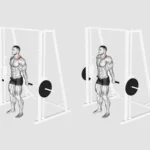Russian Twist: Exercise Overview
The Russian twist is a dynamic core exercise that enhances rotational strength and targets the abdominal muscles, with a primary focus on the obliques. This movement trains your core’s ability to rotate your torso, a function essential for everyday activities like turning to check your surroundings or performing athletic movements such as swinging a bat. When done with proper form, the Russian twist strengthens your abs, improves core stability, and supports better movement patterns. It’s a versatile addition to core workouts, full-body routines, or as a finisher in any training session.
Contents
How to Perform the Russian Twist
- Sit on a mat or the floor with your knees bent and heels resting on the ground. Your toes can lift slightly off the floor if comfortable.
- Engage your glutes to stabilize your lower body and lean back so your torso forms roughly a 90-degree angle with your thighs.
- Extend your arms straight out in front of you, keeping your hands together or holding a light weight (e.g., a dumbbell or medicine ball) for added resistance.
- Rotate your torso slowly to one side, keeping your arms extended and your gaze fixed on your hands or the weight. Pause briefly at the end of the rotation.
- Return to the center, pause for a moment, then rotate to the opposite side. Move deliberately to maintain control.
- Continue alternating sides for the desired number of repetitions or time, staying within your natural range of motion to avoid twisting your hips or knees excessively.
Tips for Optimal Performance
- Brace Your Core: Engage your abdominal muscles throughout the exercise to support your spine and enhance stability, especially when using a weight.
- Maintain a Long Torso: Keep your back straight and elongated, avoiding a rounded posture to protect your spine and maximize oblique engagement (Samuel et al., 2020). Imagine lifting your chest upward from your waist to create length.
- Keep Feet Grounded Initially: Start with your heels on the floor to build stability and master the movement. Lifting your feet can increase difficulty but may compromise form if done too soon, leading to uncontrolled leg movement.
- Extend Your Arms Fully: Reach your arms out as far as possible to create a longer lever, which increases the challenge for your core (Wirth et al., 2016). This also helps engage your abs more effectively while reducing strain on your lower back.
- Follow Your Hands with Your Eyes: Keep your gaze on your hands or the weight to ensure your shoulders rotate fully with each twist. This maximizes oblique activation and prevents half-hearted movements that reduce effectiveness.
- Move Slowly and Controlled: Avoid rushing the twist, as rapid movements can increase the risk of injury, particularly to the spine (McGill, 2010). Focus on deliberate rotations and a brief pause at the center to maintain control.
Building a rotational core with Russian twists? Learn how they fit into our Ultimate Guide to Muscle Groups for abs training.







